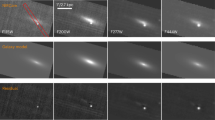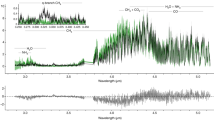Abstract
Amino acids are the essential molecular components of living organisms on Earth, but the proposed mechanisms for their spontaneous generation have been unable to account for their presence in Earth's early history1. The delivery of extraterrestrial organic compounds has been proposed as an alternative to generation on Earth2,3,4,5, and some amino acids have been found in several meteorites6,7,8,9. Here we report the detection of amino acids in the room-temperature residue of an interstellar ice analogue that was ultraviolet-irradiated in a high vacuum at 12 K. We identified 16 amino acids; the chiral ones showed enantiomeric separation. Some of the identified amino acids are also found in meteorites. Our results demonstrate that the spontaneous generation of amino acids in the interstellar medium is possible, supporting the suggestion that prebiotic molecules could have been delivered to the early Earth by cometary dust, meteorites or interplanetary dust particles.
This is a preview of subscription content, access via your institution
Access options
Subscribe to this journal
Receive 51 print issues and online access
$199.00 per year
only $3.90 per issue
Buy this article
- Purchase on Springer Link
- Instant access to full article PDF
Prices may be subject to local taxes which are calculated during checkout

Similar content being viewed by others
References
Bar-Nun, A. & Chang, S. Photochemical reactions of water and carbon monoxide in Earth's primitive atmosphere. J. Geophys. Res. 88, 6662–6672 (1983).
Oró, J. Comets and the formation of biochemical compounds on the primitive Earth. Nature 190, 389–390 (1961).
Greenberg, J. M. in The Galaxy and the Solar System 103–115 (Univ. Arizona Press, Tucson, 1986).
Brack, A. Life in the Solar System. Adv. Space. Res. 24, 417–433 (1999).
Meierhenrich, U., Thiemann, W.H.-P. & Rosenbauer, H. Molecular parity violation via comets? Chirality 11, 575–582 (1999).
Engel, M. H. & Macko, S. A. The stereochemistry of amino acids in the Murchison meteorite. Precambr. Res. 106, 35–45 (2001).
Kvenvolden, K. A. et al. Evidence for extraterrestrial amino acids and hydrocarbons in the Murchison meteorite. Nature 228, 923–926 (1970).
Cronin, J. R. & Pizzarello, S. Enantiomeric excesses in meteoritic amino acids. Science 275, 951–955 (1997).
Ehrenfreund, P., Glavin, D. P., Botta, O., Cooper, G. & Bada, J. L. Extraterrestrial amino acids in Orgueil and Ivuna: Tracing the parent body of CI type carbonaceous chondrites. Proc. Natl Acad. Sci. USA 98, 2138–2141 (2001).
Gibb, E. L., Whittet, D. C. & Chiar, J. E. Searching for ammonia in grain mantles toward massive young stellar objects. Astrophys. J. 558, 702–716 (2001).
Muñoz Caro, G. M., Ruiterkamp, R., Schutte, W. A., Greenberg, J. M. & Mennella, V. UV photodestruction of CH bonds and the evolution of the 3.4 µm feature carrier. I. The case of aliphatic and aromatic molecular species. Astron. Astrophys. 367, 347–354 (2001).
Mennella, V. et al. UV photodestruction of CH bonds and the evolution of the 3.4 µm feature carrier. II. The case of hydrogenated carbon grains. Astron. Astrophys. 367, 355–361 (2001).
Gerakines, P. A., Schutte, W. A., Greenberg, J. M. & van Dishoeck, E. F. The infrared band strengths of H2O, CO and CO2 in laboratory simulations of astrophysical ice mixtures. Astron. Astrophys. 296, 810–818 (1995).
Gerakines, P. A. et al. Observations of solid carbon dioxide in molecular clouds with the infrared space observatory. Astrophys. J. 522, 357–377 (1999).
Ehrenfreund, P. et al. Laboratory studies of thermally processed H2O:CH3OH:CO2 ice mixtures and their astrophysical implications. Astron. Astrophys. 350, 240–253 (1999).
Greenberg, J. M., Yencha, A. J., Corbell, J. W. & Frisch, H. L. in Extrait de Mémoires de la Société Royale des Sciences de Liége 425 (Société Royale des Sciences de Liége, Liége, 1972).
Briggs, R. et al. Comet Halley as an aggregate of interstellar dust and further evidence for the photochemical formation of organics in the interstellar medium. Orig. Life Evol. Biosphere 22, 287–307 (1992).
Bernstein, M. P., Sandford, S. A., Allamandola, L. J., Chang, S. & Scharberg, M. A. Organic compounds produced by photolysis of realistic interstellar and cometary ice analogs containing methanol. Astrophys. J. 454, 327–344 (1995).
Kobayashi, K. et al. Synthesis of amino acids in Earth orbit: Proposal. Adv. Space Res. 23, 401–404 (1999).
Jenniskens, P. et al. Carbon dust formation on interstellar grains. Astron. Astrophys. 273, 583–600 (1993).
Johns, R. B. & Seuret, M. G. Photochemistry of biological molecules. III. Mechanism of photodamage of alanine peptides in the solid state. Photochem. Photobiol. 12, 405–417 (1970).
Huang, Z.-H., Wang, J., Gage, D. A., Watson, J. T. & Sweeley, C. C. Characterization of N-ethoxycarbonyl ethyl esters of amino acids by mass spectrometry. J. Chromatogr. 635, 271–281 (1993).
Muñoz Caro, G. M., Meierhenrich, U. J., Schutte, W. A. & Greenberg, J. M. UV photoprocessing of interstellar ice analogs. Formation of HMT derivatives. Astron. Astrophys. (submitted).
Abe, I., Fujimoto, N., Nishiyama, T., Terada, K. & Nakahara, T. Rapid analysis of amino acid enantiomers by chiral-phase capillary gas chromatography. J. Chromatogr. A 722, 221–227 (1996).
Kissel, J. & Krueger, F. R. The organic component in dust from comet Halley as measured by the PUMA mass spectrometer on board Vega 1. Nature 326, 755–760 (1987).
Miller, S. L. A production of amino acids under possible primitive Earth conditions. Science 117, 528–529 (1953).
Bernstein, M. P. et al. UV irradiation of polycyclic aromatic hydrocarbons in ices: production of alcohols, quinones, and ethers. Science 283, 1135–1138 (1999).
Greenberg, J. M. in Comets (ed. Wilkening, L. L.) 131–163 (Univ. Arizona Press, Tucson, 1982).
Irvine, W. M., Schloerb, F. P., Crovisier, J., Fegley, B. Jr & Mumma, M. J. in Protostars and Planets IV (eds Mannings, V., Boss, A. P. & Russell, S. S.) 1159–1200 (Univ. Arizona Press, Tucson, 2000).
Chyba, C. & Sagan, C. Endogenous production, exogenous delivery and impact-shock synthesis of organic molecules: an inventory for the origins of life. Nature 355, 125–131 (1992).
Weber, P. & Greenberg, J. M. Can spores survive in interstellar space? Nature 316, 403–407 (1985).
Acknowledgements
We thank A. MacDermott, F. Goesmann and R. Roll for discussions and K. Getliffe for suggestions. Our collaboration was originally supported by the Max-Planck-Institut für Aeronomie at Katlenburg-Lindau with grants for G.M.M.C. and U.J.M., as preparatory work for the Rosetta mission. The work was performed at the Sackler Laboratory for Astrophysics at Leiden Observatory and the Centre Biophysique Moléculaire at Orléans, where it was funded by the European Union and by French sponsors: CNES, FNAD, Région Centre, and Département du Cher. In Orléans U.J.M. was supported by a Le Studium grant. U.J.M. is grateful for a habilitation grant by the Deutsche Forschungsgemeinschaft, and G.M.M.C. for an AIO allowance by Leiden University. This paper is dedicated to the memory of J.M.G., who died on 29 November 2001.
Author information
Authors and Affiliations
Corresponding author
Ethics declarations
Competing interests
The authors declare that they have no competing financial interests
Rights and permissions
About this article
Cite this article
Muñoz Caro, G., Meierhenrich, U., Schutte, W. et al. Amino acids from ultraviolet irradiation of interstellar ice analogues. Nature 416, 403–406 (2002). https://doi.org/10.1038/416403a
Received:
Accepted:
Issue Date:
DOI: https://doi.org/10.1038/416403a
This article is cited by
-
Ultrafast photoinduced C-H bond formation from two small inorganic molecules
Nature Communications (2024)
-
Progress in the development of small-celestial-body anchoring robots
Nature Astronomy (2023)
-
Chemical properties of inner and surficial regions of hydrogen-bonded clusters of biological molecules: ultraviolet photodissociation and water adsorption analyses in the gas phase
Amino Acids (2023)
-
A pathway to peptides in space through the condensation of atomic carbon
Nature Astronomy (2022)
-
Experimental identification of aminomethanol (NH2CH2OH)—the key intermediate in the Strecker Synthesis
Nature Communications (2022)
Comments
By submitting a comment you agree to abide by our Terms and Community Guidelines. If you find something abusive or that does not comply with our terms or guidelines please flag it as inappropriate.



